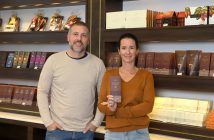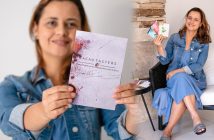Cuori di Cacao
Cuori di Cacao (cuoredicacao.com.br), owned by sisters Bibiana and Carolina Schneider, emerged in Curitiba, with the production of chocolate truffles, in the traditional manner. After some research, they found three fine cocoa producers in southern Bahia, and started operating in the world of Bean to Bar chocolates. Read below the main excerpts of our interview with Bibiana Schneider, one of the partners and founder of Cuori di Cacao. In the video, you can follow the entire interview.
Interview with Bibiana Schneider
Grão Especial – How did Cuori di Cacao emerge? I read that your mother is a chef?
Bibiana Schneider – We have a strong connection with gastronomy and our mother has always loved to cook and research food. My parents had a restaurant, and they went through a situation in which my mother was forced to put on her lab coat and go to the stove. At that time, Carolina and I were teenagers, we lived in that environment 24 hours a day. My sister already dreamed of following my mother’s footsteps, but I didn’t.
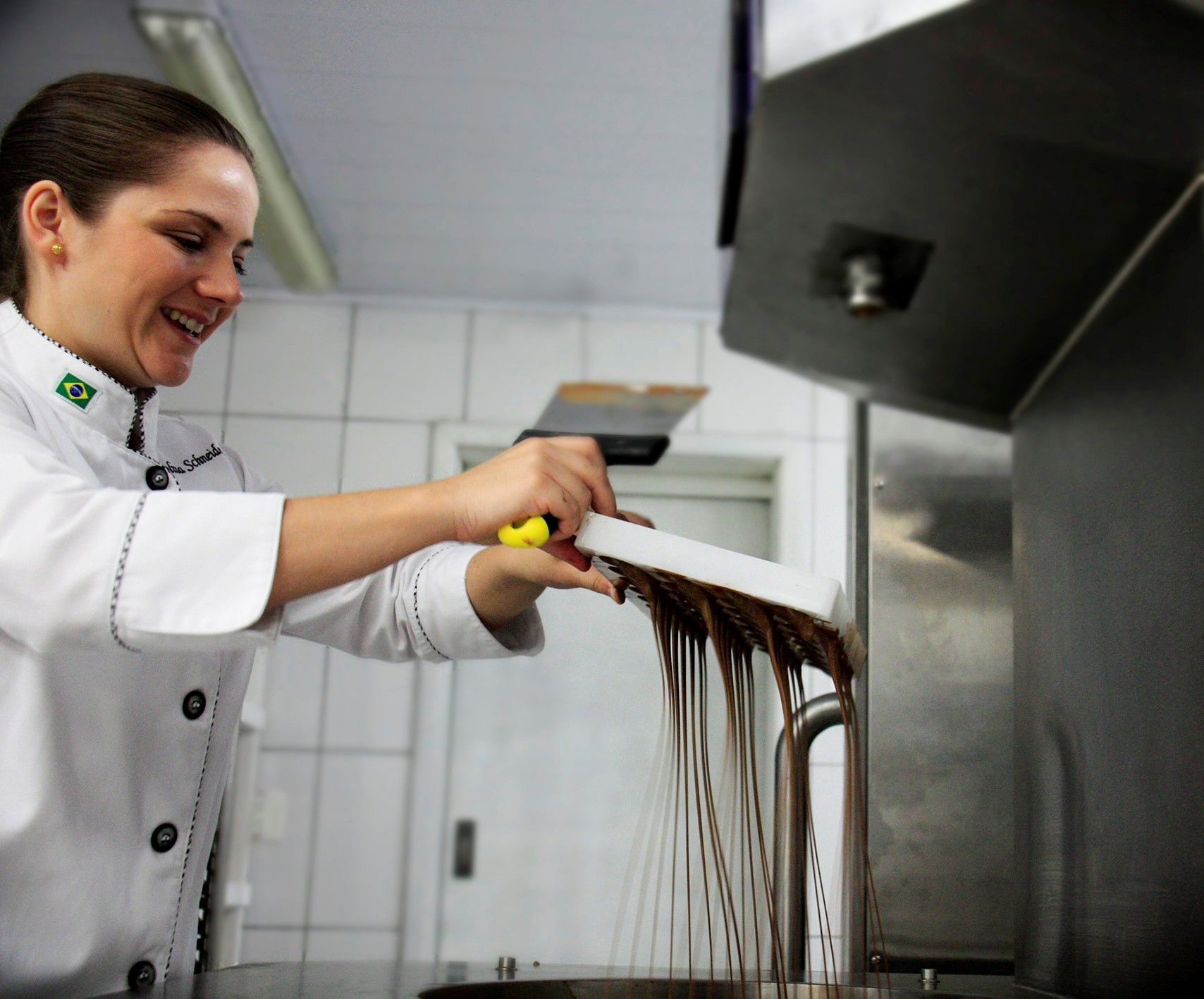
Carolina Schneider, chocolate maker at Cuori di Cacao.
Grão Especial – But, as far I know, your mother cooks snacks, right? From that point to becoming interested in chocolate, how did it happen?
Bibiana Schneider – This is the most curious part. Carolina, has always longed to work with gastronomy. At the age of 14, she applied for an internship at a very famous French restaurant, which operated here in Curitiba. Then, she went to France and Switzerland to take several courses.
Grão Especial – And was chocolate the interest of both of you?
Bibiana Schneider – No, I graduated in Fine Arts. I studied design and one day we ended up attending college. She studied gastronomy and I took the Fine Arts course. We went through this strike and, since we were doing nothing, we took an old book from my mother to try to get busy and found a recipe for chocolate truffles. We did it, it was good, my sister started offering it to some friends who, in turn, ordered it for other friends and the growth was exponential. Then, a city hotel placed orders for truffles. With all this movement, I was delighted by it and noticed that I could help with the creative process and packaging.
So, in a short time, we were completely involved, in a bigger production. In two years, we left home alone to work at the kitchen in my parents’ restaurant. From then on, we became more professional, looking for better raw materials, equipment and, soon, the dream of having our own brand came, along with a space for us to create other things with chocolate, in addition to truffles – which ended up taking place, after we finished college.
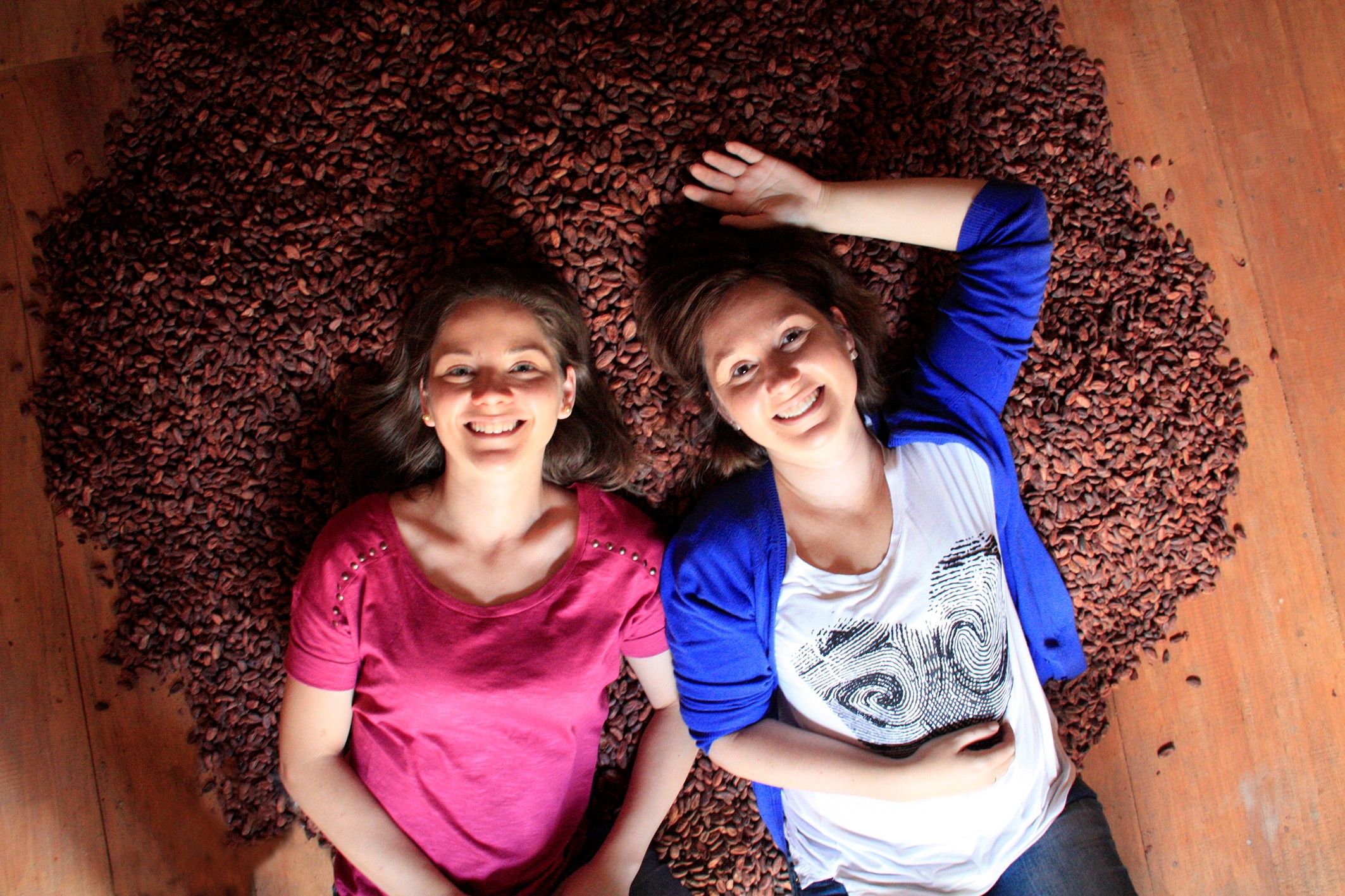
Bibiana and Carolina Schneider, partners and foundresses of Cuori di Cacao.
Grão Especial – And how did you find out about the Bean to Bar movement?
Bibiana Schneider – We dreamed of having a good Brazilian chocolate, but we thought it was impossible to produce here. Until that moment, for us, production was full of secrets, only possible to be done in large industries, with very expensive equipment. When we arrived at the Paris Salon, we received many compliments for developing the technique. They loved our chocolates and many asked us why we didn’t use Brazilian cocoa. But we didn’t even know that there was this good cocoa here or where to find that good Brazilian cocoa.
Grão Especial – And when you returned to Brazil, did you find good cocoa?
Bibiana Schneider – Yes, of course! We got three suppliers from southern Bahia. At the time, there was still much criticism regarding Brazilian cocoa, which had its image scratched abroad due to problems with the witches’ broom plague. Today, it is different, the market recognizes the effort by Brazilian producers to achieve quality. So much so that, currently, they compete on equal terms with producers from other countries. Over the years, both cocoa producers and Bean to Bar chocolate producers in Brazil have won several awards. In this sense, the world of chocolate has changed a lot, and now we share the information because we are aware that it strengthens our market.
Grão Especial – Is the work between you well split? Carolina stays in the kitchen and you in planning and marketing?
Bibiana Schneider – It was like that when we started. We soon understood that the roles were much more intertwined than we imagined. So, the visual and communication part is preferably with me, while technical development of recipes stays with Carolina. But the fact is that I have many recipe ideas and vice versa.

Bibiana and Carolina Schneider.
Grão Especial – Did you have to change the recipes to join Bean to Bar?
Bibiana Schneider – Not at first. We kept the original recipes and created a lot of chocolates Bean to Bar. We have made a name for these chocolates, included the origins and began to teach that this bar was made of cocoa from X farm and had its own characteristics. From the onset, we understood that it was necessary to make a transition, since our audience is very demanding. It was necessary to explain that we would stop working with Belgian chocolate, which has a great reputation, to work with our own chocolate, which is even better! In this way, we started to encourage our customers to buy these bars from different sources, so that they could experiment and discover their own preferences.
The experience was very successful, and gradually, we were launching new Bean to Bar products until, we moved across the line in 2018. It was not easy, because the whole balance of recipes changed and we had to adapt to that. The equipment is bigger, more expensive, but the results have been excellent!
Grão Especial – Who are your international references in the chocolate scene?
Bibiana Schneider – Wow, that is a very difficult question. When we started, we had as references very few French people who made their own chocolate. In France, there were only three chocolate-makers, including Pierre Marcolini (www.eu.marcolini.com), whom we visited on one occasion (indeed, he is Belgian). Nowadays, it is even more difficult to say, because Bean to Bar is fairly rich, there are so many people producing very high-quality chocolate and there are many brands.
Grão Especial – In Brazil, most chocolate-makers follow the American school, not the French one. Brands like Dandelion, Dick Tailor etc. are cherished here. But given the connection you had with France, it seems to me that the Cuori di Cacao chocolate goes hand to hand with the French line. Am I wrong?
Bibiana Schneider – No, it’s not wrong. The French school was our first training and it uses more classic, fine, delicate techniques, all in a very subtle manner. But we added our own base, the use of more creative, bold combinations, with ingredients from Brazilian fruits and added to all that a little of our personalities. But today we also receive the influence of the Americans.
Grão Especial – Did you start these combinations of more Chocolate Brazilian flavors with fruits? What was it like to combine chocolate with other ingredients?
Bibiana Schneider – Yes, we did. We had a talk at the last Bean to Bar Chocolate Week, in 2019, about it. We, from Cuori di Cacao and Gislaine, from Gallette (read article here) took the opposite path. Both brands started producing chocolates with industrialized ingredients, which were not Brazilian. Firstly, we developed lines of chocolates and fillings, and only then could we transform our recipes.
We now have a more affectionate look at the bars. Bringing these ingredients to our chocolate was really natural – and it is still today. Sometimes, I eat salty food and a certain flavor draws my attention. Instantly, I begin to try to harmonize it with the chocolate.
Grão Especial – Do you notice your mother’s influence in this exercise?
Bibiana Schneider – Definitely! Specially this thing of not being afraid to appropriate the gastronomic information, which is not necessarily chocolate! Allied to that, I have a mind that keeps thinking. In turn, Carolina is studying the news for everything to come out satisfactorily.
Grão Especial – You said you found the three cocoa suppliers in the south of Bahia, but what about the cocoa roasting? Because in Brazil, there is still no cocoa roasting profile. I know that in Curitiba we have Léo Moço, who is your partner and an excellent coffee roaster. Tell us a little about this experience.
Bibiana Schneider – The issue of roasting is the hitch of those who start producing chocolate Bean to Bar. It is a hell of a responsibility. When we started, there was no professional equipment for that. We did it in a convection oven, which works. Today, we have a professional roaster. The fact is that we continue to learn every day about the roasting. There is also an exchange of experiences with Léo Moço, with Lucca Cafés, who are our friends and also with other producers. The roasting parameters of cocoa and chocolate are not the same, but have some parallel. Carolina took a roasting course with consultant John Nanci, who is also the founder of Chocolate Alchemy (www.chocolatealchemy.com). She almost got nuts after the course.
Grão Especial – Nowadays, where do you roast cocoa beans?
Bibiana Schneider – We roast inside our studio. We have a professional cocoa roaster. We also took a roasting course with Arali Pedroso, professor at Castelli Escola de Chocolate (www.castelliescolachocolataria.com.br), where we learned a lot. We are developing our roasting profiles, so as each harvest comes a little differently.
Grão Especial – Currently, what is the size of Cuori di Cacao’s production?
Bibiana Schneider – Around 350 kg per month. But you know that in Brazil we have a lot of seasonality, with Easter and Christmas.
Grão Especial – Do you sell to all of Brazil?
Bibiana Schneider – We sell mostly to the southern region of Brazil. We have our store in Curitiba and several points of sale in Paraná, Santa Catarina and Rio Grande do Sul. And we ship directly to the rest of the country.
Grão Especial – Today, in São Paulo, you have several Bean to Bar chocolate producers, the association is here, and Cuori di Cacao broke several resistances. It has created its own market away from the Rio-São Paulo axis and this is admirable. Did you ever feel any resistance?
Bibiana Schneider – It is funny. A while after the Bean to Bar movement started in São Paulo, I became the association’s vice president. Today, we have a very nice relationship, we broke up with a series of patterns and I use to joke saying that we are either brave or totally insane! And this is very good! We did it because we believed that we had to do it that way. But even today, we feel this distance, this difficulty in making ourselves noticed. The eyes, mainly of the media, still see more Rio and São Paulo. It is very difficult to make yourself noticed in the same manner, we are worth as much as these two are! It is an effort that we have to make every day. Without marketing, we wouldn’t be noticed!
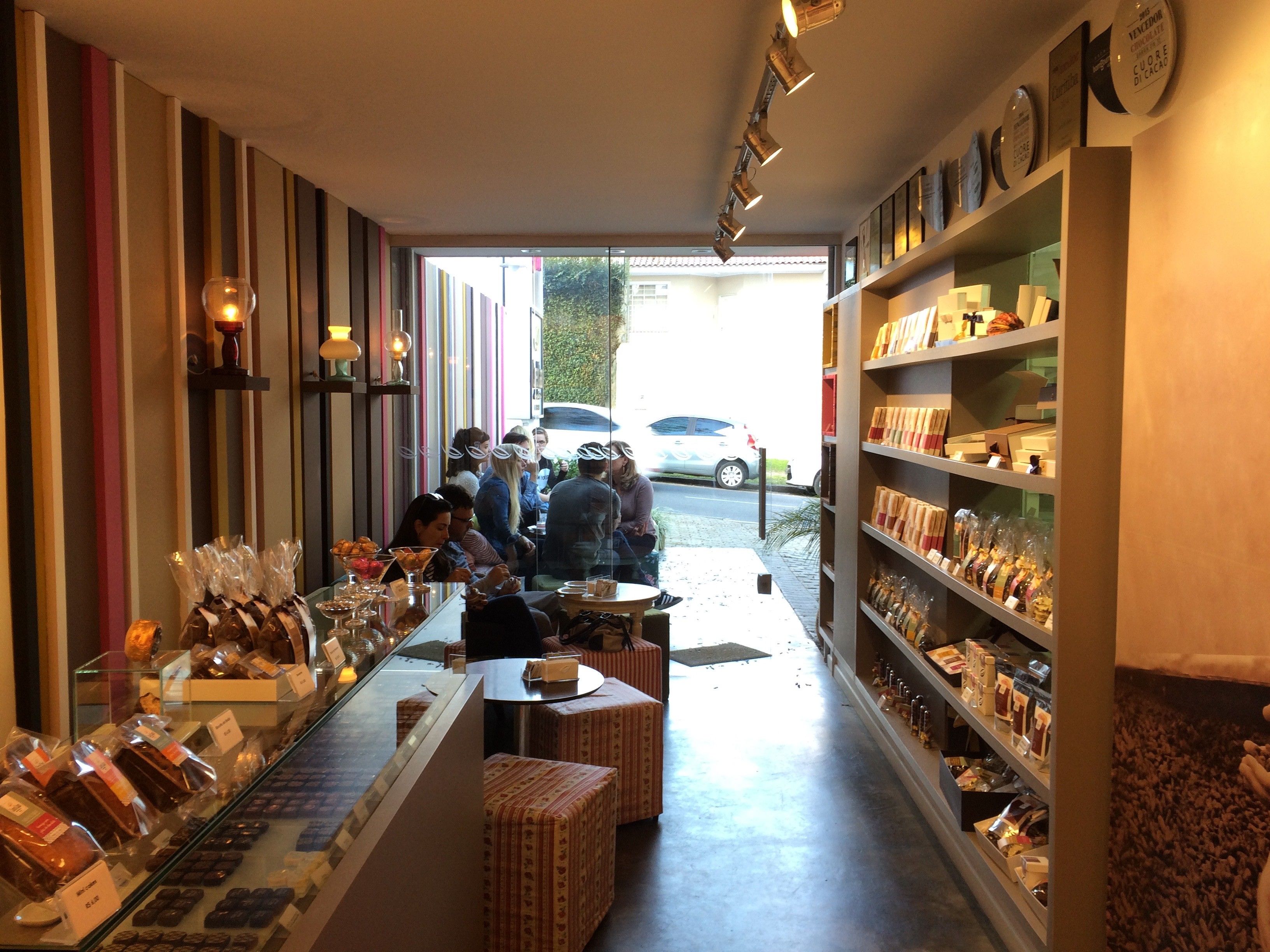
Cuori di Cacao is a brand that was born in Curitiba.
Grão Especial – In this time of coronavirus, how did the pandemic affect your business?
Bibiana Schneider – Most of our Easter production was already fully produced and packaged when the pandemic arrived here. We changed communication, decisions were changed all the time, the way we work internally changed. But, despite all the difficulties, we had a great Easter, we sold everything, it was a surprise. Another thing: people have gifted themselves with moments of pleasure, customers have sent many more gifts. We are not in a bed of roses, but we cannot complain. There is a new market to explore. There are other ways to get there. There is hope!
Grão Especial – The city of Curitiba eased the isolation and then had to go back and close the trade again. How are you operating?
Bibiana Schneider – We are operating with a reduced team, on alternate days, but we have been selling. Only one customer can enter the store at a reduced time. But we have made deliveries as well.
Grão Especial – What about the Cuori di Cacao chocolate? What do you suggest for people to discover the real chocolate? What is this path?
Bibiana Schneider – I will approach our award-winning chocolates. We have in our portfolio, a chocolate that received two international medals, one of which was gold. It is a 70% cocoa chocolate with cashew nuts and fleur de sel. It has some bitterness, a light and very pleasant acidity, the crispness of the chestnut, which give a Brazilian taste to this combination as well as a touch of the fleur de sel, providing a really cool sensation in the mouth. It is one of our best sellers.
Another chocolate that has received an international award is milk chocolate with 38% cocoa. It is a well-caramelized chocolate, which takes toasted mate tea. Mate tea caramelizes in this process, has a touch of bitterness, of astringency, and it is very surprising. In addition, it has a very beautiful history. To create this chocolate, we had our grandmother’s house as a reference. Every afternoon, I had biscuits and mate tea with milk; it was a very personal thing that we thought people would not understand much, despite being a delight. But people do understand it. So much so that it received a silver medal at the Academy of Chocolate, London. Our own milk chocolate is very successful. It is caramelized with cane molasses, and it is a mixture that is very rich on the palate.
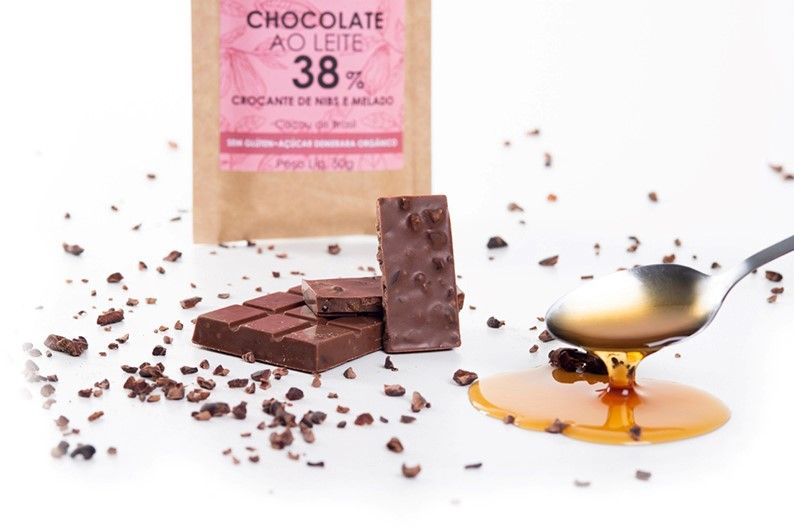
Award-winning chocolate at the Academy of Chocolate, London.
Grão Especial – What makes up the chocolate of Cuori di Cacao?
Bibiana Schneider – Our chocolate contains only cocoa and organic demerara sugar. Nothing beyond that. Milk goes only in milk chocolate.
Grão Especial – Please explain to the general audience how one can recognize good chocolate.
Bibiana Schneider – Consumers should follow some rules to avoid being deceived. The first thing is to read the packaging and check the list of ingredients. Cocoa has to be the star of the recipe. It cannot be followed by fats other than cocoa butter and, also, it cannot have any type of flavoring. When you open the packaging, you have to smell the chocolate, smell it. Our nose is a great sensory device.
Grão Especial– And what about the noise?
Bibiana Schneider – The snap gives us a clue. The hearing is also part of the tasting process. When a piece of chocolate is broken, you must hear the cracking sound. This means that it is well-seasoned and that its texture is also suitable. And it takes a lot of attention on the first bite! It’s the main thing. You can’t get distracted and you must keep all your attention at that time. With the chocolate in your mouth, let it first melt. You will feel, on the tongue, whether it has a final, homogeneous texture. Then, we will observe the acidity, the bitterness, the notes of fruits, spices and chestnut.
That’s why the world of chocolate Bean to Bar is so rich! I buy chocolates from several colleagues who produce them. I wish different impacts on the mouth. Exotic fruits, brownie etc. And it is always important to remember that chocolate is not a candy. Chocolate is Chocolate!


